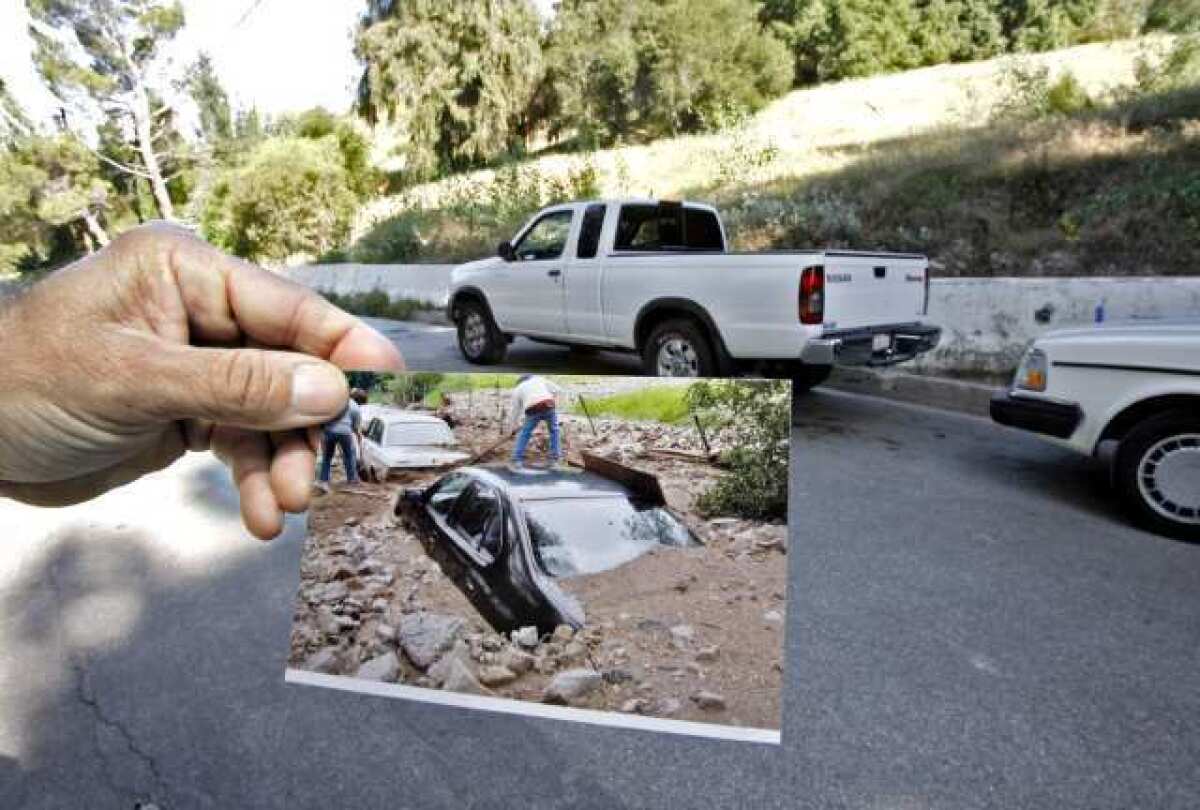Storm barriers must remain in hillside neighborhoods

La Cañada Flintridge homeowners may hate them, but the barriers that have lined hillside streets since the 2009 Station fire aren’t going away any time soon.
Scientists with the U.S. Department of Agriculture’s Natural Resources Conservation Service visited four La Cañada neighborhoods on May 8 to weigh the risks of removing the barriers, known as K-rails. The verdict: Loose dirt and a dearth of deeply rooted shrubbery in burn areas make for a continued threat of mud and debris flows during heavy rains — meaning the curbside fortifications must stay put for another year or longer.
“On this thin soil and these steep slopes, you need to give it some more time for native species to take hold. I’d say we’re not quite there yet,” said John Harrington, the agency’s state conservation engineer for California.
The news is disappointing for many homeowners but should not come as a shock in areas where walls of mud and rock overwhelmed streets, flooded yards and invaded more than two dozen homes in February 2010.
At that time, officials cautioned that it could take five to seven years before the area recovered enough from the 161,000-acre Station fire to see the barriers removed.
The latest survey, done at the request of Rep. David Dreier (R- San Dimas), examined hillside areas above Haskell Street and Big Briar Way, Rock Castle Drive, La Forest Drive, and the Paradise Valley neighborhood atop Ocean View Boulevard.
Harrington and his team were accompanied by officials with the Los Angeles County Department of Public Works, which maintains area catch basins and installed the K-rails.
Department of Public Works spokesman Kerjon Lee said officials may remove some barriers in La Crescenta neighborhoods, but plan to leave the K-rails in La Cañada.
Residents see the debris walls as either a reassuring presence or an unwelcome reminder of disaster.
Margaret Manatt, who has lived on La Forest Drive for 43 years, would like to see them go.
“I’m willing to take that chance,” said Manatt, complaining that K-rails hinder views and depress property values. “It seems to me [the hills] have grown back, and we haven’t had those torrential rains.”
But Gilbert Jacobi, who lives near the top of La Forest, credits the K-rails with saving his home.
“We’re for waiting the full five years. Just having them here helps us sleep a bit better when it rains,” said Jacobi.
Harrington and agency geologist Julia Grim noted in their May 11 report that foliage above La Forest consisted of “shallow-rooted weeds and other annuals, rather than deep-rooted shrubs” that could prevent erosion.
The report identified “patchy but significant vegetative recovery” above Ocean View, but cautioned that boulders and debris still linger above the Mullally debris basin on Manistee Lane.
Paradise Valley sustained the heaviest damage after the Mullally basin plugged and overflowed in 2010.
The county later increased Mullally’s capacity from 9,400 cubic yards of sediment to 17,500.
Installation of a 600-foot underground storm-water drain connecting the basin to Pickens Canyon will break ground in the summer of 2013, Lee said. The project will cost about $700,000 and take three months to complete.
That’s too late for Maureen Kindred, who is selling her home on Ocean View. She says the K-rails have scared off several potential buyers. Kindred’s neighbors on either side had houses full of mud in 2010, but a downed tree blocked her driveway and prevented the flow from reaching her home.
“It affects the value [and] makes people afraid,” she said, adding that the double-disaster of massive wildfire and resulting mudslides “might happen once every hundred years, but I certainly don’t think it’s going to happen again in our lifetime.”
Harrington said that lighter-than-average rainfall in the past six months has disguised potential risks.
“We’re not waiting for another heavy rainfall to make a decision, but the watershed was definitely not tested this winter,” he said.